Northern NY Agricultural Development Program 2006 Project Report
Project Leader(s):
Anita Deming, Executive Director, Cornell Cooperative Extension Association of Essex County, Westport NY, 518-962 –4810 ext 409, ald6@cornell.edu
Kevin Iungerman, Cornell University Extension Associate, NE NY Commercial Fruit Program, Ballston Spa NY, 518-885-8995, kai3@cornell.edu
Collaborator(s):
Mike Davis, Cornell University E.V. Baker Agricultural Research Farm at Willsboro, NY
Steve Lerch, Research Support Specialist 2, NYS Experiment Station, Geneva, NY
Farmer participants:
- Rob McDowell – Lake Champlain Grape Growers Association in Clinton Co
- Kathryn and Will Reinhart – Lake Champlain Grape Growers Association in Essex Co
- 22 additional farmers attended our training sessions and workshops see appendix.
Background:
This is a continuing project from May of 2005 to evaluate 25 varieties of grapes for cold hardiness. The initial planting was primarily funded by a NY Farm Viability Institute grant. This is a transition year where the grapes were to be matured in preparation for a crop in 2007. We have been using the project to teach local farmers about raising grapes and how to care for them.
Methods:
In 2006 “working seminar sessions” enabled volunteers and Cornell University researchers Steve Lerch and Kevin Iungerman to accomplish trellising, vine pruning and training, comparative berry tasting, and complete harvest clean-up – and in the process, dealt with many of the horticulture skills and crop management practices needed for vineyard operation.
This hands-on instruction also served to illustrate the relative merits of the different vines, and set the stage for dormant season evaluations of winter acclimation, survival performance, and vigor.
The Northeast Fruit Program succeeded in establishing a unique, 300-vine trial of 25 different cold-hardy-wine-grape cultivars at the Cornell E. V. Baker Agricultural Research Farm in Willsboro in 2005. This was achieved with the help of private and land-grant collaborators, and funding partners.
2006 served as a second establishment year. Growth performance and vine pruning and training practices largely mitigated initial differences; cropping was largely avoided to focus on vine maturation. A small amount of cropping was permitted for vigor control and also for identification and educational purposes.
An interim and on-going purpose of the Willsboro Trial is to foster horticulture skills and crop management practices while learning about the relative merits of the different vines. On-site educational sessions and especially “working seminar sessions” (where participating volunteers assist the Cornell researchers at different seasonal points) were the chosen instructional approaches.
In 2005, volunteers and visitors had learned about the purpose of the trial, site preparation, vine planting, trickle irrigation and early care, small sprayer use, and trellising posts and deer fence construction.
In 2006, our “working seminars” continued:
- April 13 – String up trellis wiring and complete trellis construction.
- April 28,29 – Shoot selection, positioning, training, and tying. Bud and growth stage evaluation introduction based upon Eichorn and Lorenz scheme.
- April 29 – Grape IPM Presentation and Question and Answer Session with Tim Weigle of the NY IPM Program.
- July 18 – Second shoot selection, positioning, training, and tying session. Examination for pest and disease problems.
- August 8 – Joint Apple- Grape Field Day. (Grape Timing: mid season, pre-veraison [i.e. coloration])
- September 23 – Final maturity review and examination, and grape tasting with discussion of flavor. Completed vine harvest and sanitation. Crop shared with participants. (Regular participants/workers take the excess grape crop to learn how to make wine and other grape value added products).
While timing and various standardized protocols prevent the Willsboro Trial from being a fully recognized NE 1020 site, the Formal Organizing Participants to the USDA NE 1020 Multi-state Grape Clonal Evaluation Program have invited Kevin Iungerman to maintain an auxiliary and supportive role in all developing 1020 proceedings. A component sub-group represents cool climate growing conditions and very cold winters similar to our region. These NE 1020 researchers, and the participants as a whole, will prove to be valuable resources to the Willsboro and northern NY grape efforts in the coming years. The University of VT, for instance, will be planting a NE 1020 in 2007.
Results:
Vine growth performance differences were extensive; however, these were not site, nor climate induced. Rather, initial vine variability was the presenting problem — largely as a result of procurement issues. The very uniqueness of the vines meant that a variety of different nurseries served as sources for the final vine complement at Willsboro.
Variation also was due to other factors: the differences in available planting stock (bare root or softwood cuttings); the lateness of order placement (arising from uncertainty as to support funding and the cooperative consultative process in planning the trial; and — in limited instances — the necessity of multiple planting dates. Softwood plants could not be planted with bare rootstock due to greenhouse readiness issues as well as concerns with early shipping or planting freezes. Despite these initial obstacles, the trial was put in place in record-time (comparable to similar evaluative trials). These were ongoing issues from the 2005 planting. However, this year’s good growing season saw all cultivars gain equal footing or readiness for the 2007 cropping year.
Fifteen regular volunteers assisted the researchers over the 2006 growing season, and 25 growers and guests attended the various events. Participants from Vermont, Canada, and the Capital District of NYS are regulars at the working sessions. The growers have opportunities to work and talk to seasoned veterans of viticulture research for 2 to 4 hours as they learn with hands-on experience. Growers bring samples from their vineyard to the meetings to share and discuss at the meetings as well.
Conclusions/Outcomes/Impacts:
By early October, the vines had achieved relatively comparable establishment across the different replications. The trial’s overall good condition should afford a fairer comparison of winter acclimation, survival performance, and future growth and cropping comparisons over the 2006-2007 dormant period and the 2007 growing season.
Farmers report an intense learning curve that has helped them with their home plantings. We have had 3 expansions and 2 new plantings on the NY side of Lake Champlain since this project started. The farmers have been very active in helping design the research projects, implement the projects, and trying new things at home. Among the comments:
Norbert St. Pierre: I have been able to talk to State experts and to ask every question I can think of. They have helped me with pest issues, pruning and trellising issues. I have taken cuttings home and planted them in the clay soil that I have available in Crown Point and the sandy soil in Witherbee. I have made wine from several varieties without the use of sulfur.
Kathryn Reinhart: My husband and I have planted some of the varieties at home. We have started a more aggressive weed control program based on what I have seen at the Willsboro site. We are making wine now for our use and for gifts.
Rob McDowell: This has been a tremendous experience for all of us. I am surprised at how many people are interested in this project. We have had the Channel 5 news out for our workshops, people call frequently to ask questions about what is the best variety (we don’t know yet). Our membership is increasing. I really want to look at organic production.
Libby Treadwell: We have planted 300 vines in Westport on a clay slope. The bugs are a problem and we are hand picking. It is good exercise.
Outreach:
Workshops are promoted on the cce_cold_country_viticulture-L list serve, in NNY newsletters, in Glens Falls, Albany, Plattsburg, Watertown and weekly newspapers, and by word of mouth. The Valley News, the Press Republican and the Times of Ticonderoga have run articles on the research project in Willsboro. The Channel 5 WPTZ news has been to the site and reported on the project. There were 4 articles in the NE NY Small Fruit Newsletter about the grape planting and growing grapes in general.
Next steps.
2007 and the next 4 to 5 years will be the true test of the cold hardiness of the cultivars selected. A number of ambitious lab and field procedures will describe comparative survival, hardiness, vigor, and maturity indices of these grapes. The envisioned work will:
A) Conduct an examination of the extent of each wine grape cultivar’s site adaptation responses as suggested by a 2006-2007 dormant season examination of its vigor and growth habits as indicated by its 2006 wood production.
B) Conduct an examination, tabulation and summarization of various dormant season acclimation and over-wintering capability (mortality) indicators
C. Develop cultivar-specific, degree-day related, base-line information profiles regarding flowering onset, berry and cluster formation incidence, and maturity and yield component indices (via limited, sequenced weekly berry sampling and development evaluation in August and September 2007).
D. Normal research maintenance as well as pest, and vine growth condition monitoring will be carried out and these activities will be included among outreach activities.
Acknowledgments:
- Northern NY Agricultural Development Program for funding
- Cornell E. V. Baker Research Farm Willsboro for land, and labor from Mike Davis
- NYS Agricultural Experiment Station, Geneva, for work and education esp Steve Lerch and Bob Pool and Hatch funding for Steve’s travel and time.
- NY Farm Viability Institute for the initial planting grant
- Lake Champlain Grape Growers Association for work done and organizing meetings.
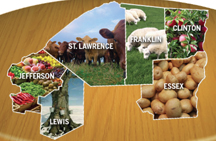 NNYADP horticultural research supports ever-increasing consumer interest in locally-grown foods and local farms movement. Field-tested, data-based results from NNYADP projects support local food hubs development, and advance production and season extension techniques for growing everything from salad greens and tomatoes to “super fruits” and, in 2023, NNYADP research added cold-hardy nut trials. The Juneberry research nursery, established in Willsboro with NNYADP support, is the first of its kind for New York State.
NNYADP horticultural research supports ever-increasing consumer interest in locally-grown foods and local farms movement. Field-tested, data-based results from NNYADP projects support local food hubs development, and advance production and season extension techniques for growing everything from salad greens and tomatoes to “super fruits” and, in 2023, NNYADP research added cold-hardy nut trials. The Juneberry research nursery, established in Willsboro with NNYADP support, is the first of its kind for New York State.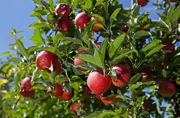
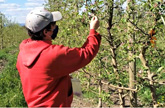

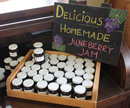 BERRIES
BERRIES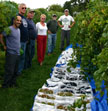
 HIGH TUNNEL CROPS
HIGH TUNNEL CROPS